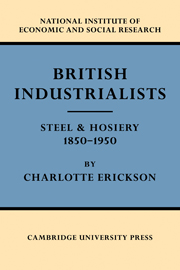Book contents
- Frontmatter
- Contents
- LIST OF TABLES
- Foreword
- Introduction
- I SCOPE OF THE INQUIRY
- II SOCIAL ORIGINS OF THE STEEL MANUFACTURERS
- III CAREERS OF THE STEEL MANUFACTURERS
- IV SOCIAL ORIGINS OF THE NOTTINGHAM HOSIERS
- V CAREERS OF THE HOSIERY MANUFACTURERS
- VI THE INTRODUCTION OF NEW TECHNIQUES IN STEEL-MAKING
- VII HOSIERY INNOVATORS
- VIII THE PUBLIC COMPANY
- Appendix A Selection of firms
- Appendix B List of firms included in steel study
- Appendix C Selection of men for steel study
- Appendix D The hosiery samples
- Appendix E Classification of fathers' occupations
- Appendix F Notes on comparisons with Population Census
- Appendix G Education
- Appendix H Marriages
- Appendix I Careers
- Appendix J Public company tables
- List of Principal Works Cited
- Index of names
- Index of companies
- General index
- PUBLICATIONS OF THE NATIONAL INSTITUTE OF ECONOMIC AND SOCIAL RESEARCH
VIII - THE PUBLIC COMPANY
Published online by Cambridge University Press: 07 October 2011
- Frontmatter
- Contents
- LIST OF TABLES
- Foreword
- Introduction
- I SCOPE OF THE INQUIRY
- II SOCIAL ORIGINS OF THE STEEL MANUFACTURERS
- III CAREERS OF THE STEEL MANUFACTURERS
- IV SOCIAL ORIGINS OF THE NOTTINGHAM HOSIERS
- V CAREERS OF THE HOSIERY MANUFACTURERS
- VI THE INTRODUCTION OF NEW TECHNIQUES IN STEEL-MAKING
- VII HOSIERY INNOVATORS
- VIII THE PUBLIC COMPANY
- Appendix A Selection of firms
- Appendix B List of firms included in steel study
- Appendix C Selection of men for steel study
- Appendix D The hosiery samples
- Appendix E Classification of fathers' occupations
- Appendix F Notes on comparisons with Population Census
- Appendix G Education
- Appendix H Marriages
- Appendix I Careers
- Appendix J Public company tables
- List of Principal Works Cited
- Index of names
- Index of companies
- General index
- PUBLICATIONS OF THE NATIONAL INSTITUTE OF ECONOMIC AND SOCIAL RESEARCH
Summary
A Prime Minister who had once been managing director of a public company in the steel industry said in 1928: ‘Since the days when private industry gave place to the joint stock company there have battened on the joint stock companies large numbers of men connected with the management, and directors, who are parasitical and nothing but parasitical.’ At the very time he was speaking—in the late 'twenties—changes were being made in some of the firms in this industry where joint stock companies were at last nearly universal, changes which by 1953 were to make the parasitical officer and even the officer who was not an executive in the industry an anachronism. Some of these changes must clearly be attributed to the particular difficulties which the steel industry faced during these years, and others perhaps to broader developments in society itself. It is the purpose of this chapter to focus attention upon the public company in the two industries, hosiery and steel, in an effort to discover in what respects the joint stock company structure itself has been responsible for recent developments in management recruitment. Since public companies are on the whole larger units, both of ownership and operation, than private companies and partnerships, this inquiry can be expected to throw some light on the influence of large-scale production, as well as the dispersion of ownership, on management recruitment.
- Type
- Chapter
- Information
- British IndustrialistsSteel and Hosiery 1850–1950, pp. 188 - 203Publisher: Cambridge University PressPrint publication year: 1959



